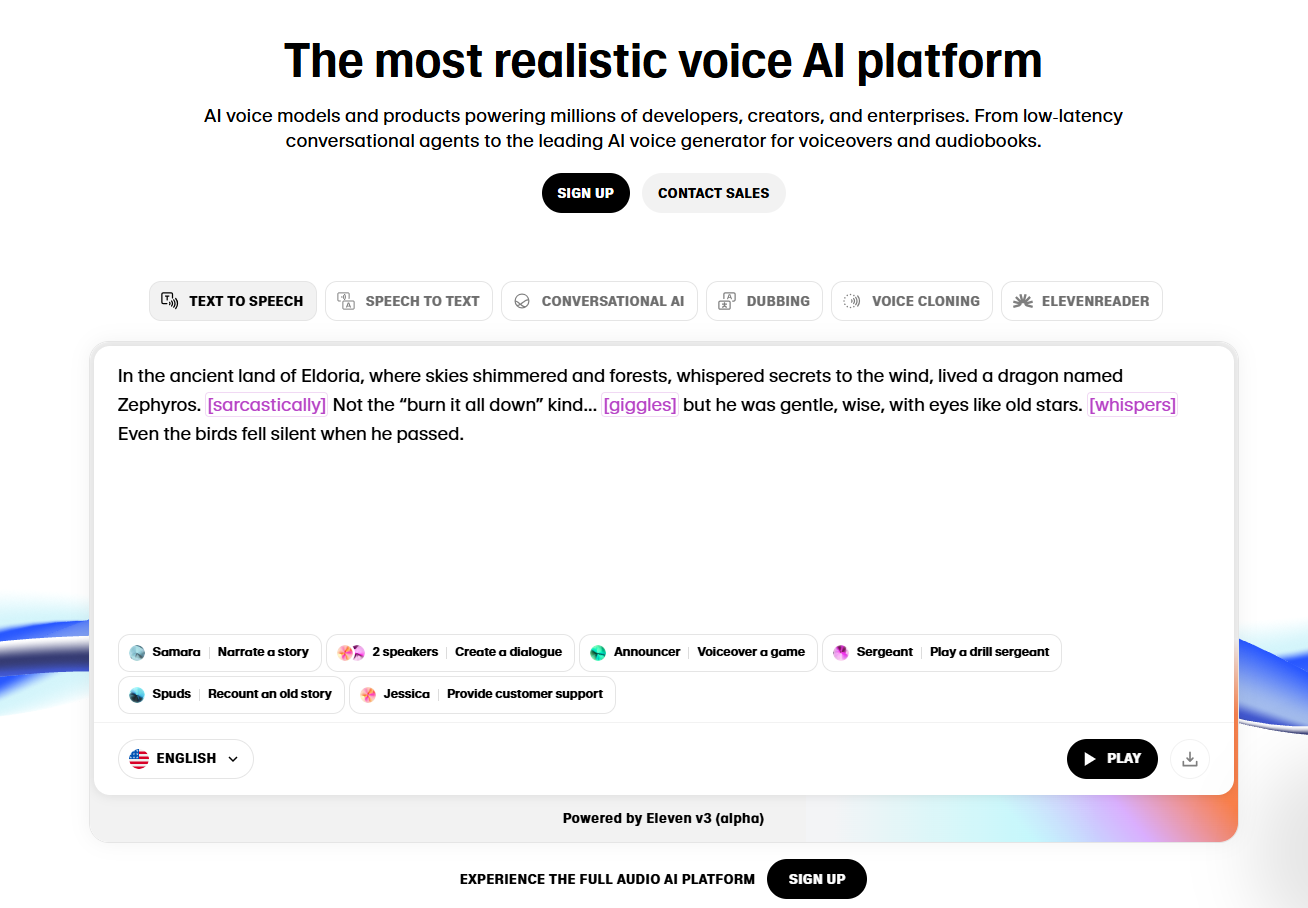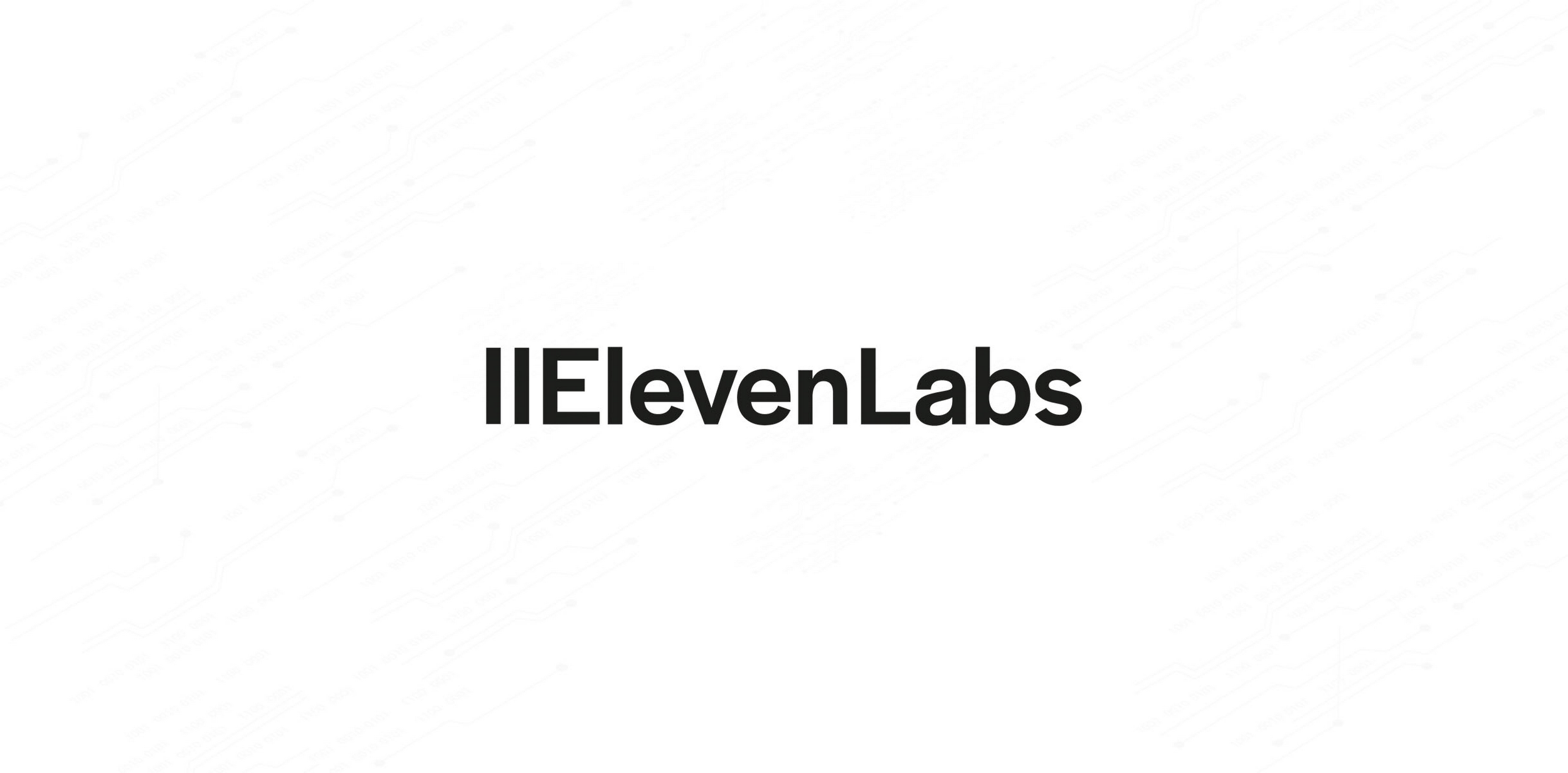Ggenerative-AI apps have transformed synthetic speech from a curiosity into a newsroom-level necessity. Marketing agencies, podcasters, audiobook publishers, and e-learning teams now expect studio-grade narration on demand—often in multiple languages and delivered the same day a script is approved. The latest generation of voice engines combines deep-learning prosody modeling, voice-cloning, and speech-to-speech transfer, making it possible to create dialogue that feels genuinely performed rather than recited.
Below is an up-to-the-minute look at the platforms setting the bar in 2025, followed by a practical framework for choosing the right tool for your workflow.

ElevenLabs — Version 3 raises the ceiling on expressiveness
ElevenLabs’ June 2025 “v3” release added inline audio tags that let writers drop cues such as [whisper], [sarcastic], or [breath_long] directly into a script. A new Dialogue Mode synchronizes multi-speaker exchanges so voices naturally overlap and interrupt, while language coverage jumped to 70-plus tongues with regional accents. The company’s VoiceLab still turns a 60-second sample into a high-fidelity clone, but v3’s bigger win is nuance: stress, pitch inflection, and pacing now respond to context rather than blunt punctuation cues. If ultra-realistic storytelling or audiobook work is central to your business, v3 remains the reference standard.
Resemble AI — Real-time speech-to-speech with built-in watermarking
Resemble’s Speech-to-Speech pipeline converts a human performance into a synthetic voice in roughly 150 ms, preserving timing and emotional tone—handy for games, interactive learning, and live dubbing of Zoom calls. Its proprietary neural watermark embeds a cryptographic signature in every generated file, satisfying brand-safety and EU AI Act disclosure rules without audible artifacts. Enterprise users also get Projects (collaborative voice asset management) and a low-latency API that slots neatly into Unity and Unreal.
Amazon Polly & Nova Sonic — Scalable voices for global products
Polly’s catalog now tops 100 neural voices, but 2025’s headline was Nova Sonic, a unified speech model on Amazon Bedrock that handles recognition and generation in one pass. The result: sub-300 ms streaming latency—crucial for conversational agents—and pricing that stays predictable at scale. Developers can deploy Nova Sonic inside the same stack that already hosts GPT-4o or Claude 3, making it the pragmatic pick for multilingual customer-service bots and IoT assistants.
Murf AI — All-in-one studio for scripts, slides, and team reviews
Murf bundles 200 voices in 20 languages with a Google-Docs-style editor that supports track changes, timed slide sync, and automatic emphasis suggestions. Version 2 of its neural TTS model brings richer micro-pauses and breath control, while Murf Dubbing lets you layer translated voice-overs onto video with frame-accurate alignment. Because everything lives in a browser tab, non-technical teams can produce broadcast-ready narration without touching an IDE.
Listnr, Fliki, LOVO, Maestra, HeyGen, Play.ht, WellSaid Labs
- Listnr excels at blog-to-podcast pipelines, RSS ingestion, and dynamic ad-insertion for monetized feeds.
- Fliki converts scripts into fully captioned videos, pairing AI stock footage with multilingual voice-overs—ideal for TikTok explainers and quick product demos.
- LOVO offers a Voice Marketplace where actors license bespoke tones; its Emote Control panel lets producers slide between joyful, neutral, or angry deliveries.
- Maestra focuses on automatic transcription and cross-language dubbing, producing 95 %+ accurate subtitles and synced voice tracks in one export.
- HeyGen marries photorealistic video avatars with neural speech, letting brands localize training modules without reshoots.
- Play.ht appeals to WordPress users with a plug-in that publishes audio versions of posts in a single click.
- WellSaid Labs positions itself as the compliant choice for Fortune 500s, offering SOC 2 Type II certification and a human-voiced “quality gate” before any new clone goes live.
Quick-Pick Matrix
| Primary Use Case | Recommended Platforms | Key Advantages |
|---|---|---|
| Audiobooks & Narrative Podcasts | ElevenLabs v3, Resemble AI | Expressive tags, long-form coherence, high-quality voice cloning |
| Real-Time Dialogue & Games | Resemble AI, Amazon Nova Sonic | Sub-200 ms latency, speech-to-speech conversion, neural watermarking |
| Multilingual Customer Support | Amazon Polly / Nova Sonic, Google Cloud TTS, Microsoft Azure Neural TTS | Wide language coverage, scalable pricing, SSML tuning |
| One-Click Blog-to-Audio | Listnr, Play.ht, Fliki | WordPress plug-ins, RSS automation, dynamic ads |
| Video Localization & Training | Murf AI, Fliki, HeyGen, Maestra | Slide timing tools, avatar dubbing, frame-accurate transcription |

Feature Checklist Before You Subscribe
- Natural prosody controls – Look for inline tags or emotion dials rather than rigid SSML breaks.
- Language depth, not just count – Check for regional accents and code-switching support if your audience spans markets.
- Clone retention policy – Verify how long your voice data is stored and whether you can revoke it.
- Content watermarking – Essential for compliance as synthetic-speech disclosure rules tighten.
- Latency ceiling – Anything above half a second will feel laggy in interactive apps.
- Pricing model – Character-based billing punishes long scripts; hour-based plans may be cheaper for podcasts.
- Integration stack – REST and WebSocket APIs are table stakes; look for native plug-ins for Adobe Audition, Premiere Pro, or Unreal if those live in your pipeline.
Armed with these benchmarks, you can match the right engine to your creative needs—whether that’s a global e-learning rollout, an immersive RPG, or a daily tech-news podcast that demands human warmth on a machine schedule.
A Look At The Best Ai Voice Generation Tools
AI voice technology has transformed how we create audio content in recent years. These advanced tools can turn simple text into natural-sounding speech that’s nearly indistinguishable from human voices. From content creators to business professionals, many people now use AI voice generators to produce voiceovers, narration, and audio content without hiring voice actors or recording themselves.
The best AI voice generators offer realistic speech with natural intonation, multiple language options, and customizable voices that can match specific project needs. Companies like ElevenLabs and Murf AI have developed platforms that provide numerous voice options across different languages. These tools save time and money while allowing users to create professional-sounding audio content with minimal effort.
1. ElevenLabs AI Voice Generator
ElevenLabs stands as one of the leading platforms in AI voice generation technology. This powerful tool allows users to create realistic voice overs across 32 different languages, making it versatile for various applications.
The platform offers both free and premium voice options with noticeable quality differences. Many users report that the premium voices provide better results, though quality can vary significantly between different voice models.
ElevenLabs’ most distinctive feature is its voice cloning capability. Users can train the AI to speak in their own voice, creating personalized audio content that maintains natural speech patterns and inflections.
The platform includes a variety of pre-made voices with different accents and characteristics. British voices like Christopher, Amelia, and Archie are particularly popular among users seeking UK accents, though some users note a need for more high-quality British options.
For professional content creators, ElevenLabs offers tools to produce voiceovers that sound remarkably human. The text-to-speech functionality converts written content into spoken word with appropriate emphasis and natural cadence.
The platform continues to improve its algorithms, with recent updates enhancing the overall quality and realism of generated voices. This makes it a valuable tool for podcasters, video creators, and developers who need professional-sounding voice content.
ElevenLabs can be particularly useful for dubbing content across languages, helping creators reach international audiences without requiring multiple voice actors. This functionality saves time and resources while maintaining consistent voice quality.
2. Speechify Text to Speech
Speechify stands out as one of the leading AI voice generators on the market today. This powerful tool transforms written text into natural-sounding speech with remarkable accuracy.
Speechify offers an impressive library of over 200 natural, lifelike voices across more than 60 languages. Users can select from these voices or even clone their own voice for a personalized experience.
The platform is known for its human-like cadence, making the audio output sound less robotic than many competitors. This natural flow is particularly valuable for creating content that needs to engage listeners.
One of Speechify’s standout features is the ability to read text up to 4.5 times faster than average reading speed. This efficiency helps users save significant time, with the company claiming its customers save up to 9 hours weekly.
The versatility of Speechify makes it suitable for various applications. It works well for creating audiobooks, YouTube videos, corporate training materials, advertisements, and many other content types.
Users can access over 1000 lifelike AI voices through Speechify’s platform. The service also offers 13 different emotions to add depth and context to the generated speech.
Content creators appreciate Speechify’s ability to narrate text for videos, explainers, and various other formats in real-time. The quality of the voice over recordings is often described as human-quality.
The free version of Speechify allows users to download their generated audio as MP3 files without requiring signup. This accessibility makes it easy for new users to test the service before committing.
Speechify has received strong user feedback, with over 250,000 five-star reviews. This level of positive reception indicates high user satisfaction with the service’s performance and features.
3. WellSaid Labs
WellSaid Labs stands out as a professional AI voice generator with a focus on creating natural-sounding voiceovers. The company prides itself on being the “safest and simplest AI voice generator” while achieving close human parity in its output.
Users appreciate WellSaid for its word-by-word control capabilities. This feature allows content creators to fine-tune pronunciations and emphasize specific words, giving them precise control over the final audio.
The platform offers a variety of dialect options and production styles to match different project needs. Whether creating educational content, marketing videos, or corporate presentations, creators can find suitable voice options.
Security is a key selling point for WellSaid Labs. The company emphasizes its secure approach to AI voice generation, which can be particularly important for businesses with confidentiality concerns.
For YouTube creators specifically, WellSaid provides professional-quality voiceovers that can enhance video content. The natural-sounding voices help maintain viewer engagement without the robotic qualities found in some AI voice tools.
The WellSaid platform allows users to try their text-to-speech AI voices for free before committing. This gives content creators the opportunity to test different voices and determine if they match their project requirements.
When compared to other voice generators like ElevenLabs, WellSaid offers different strengths. Some users have created comparison videos analyzing the features, pros, and cons of both platforms.
For companies looking to create their own AI voice, WellSaid Labs offers solutions to develop custom voiceovers that align with brand identity. This can be valuable for maintaining consistent audio branding across multiple content pieces.
4. LOVO AI
LOVO AI stands out as one of the most advanced text-to-speech platforms available today. The service offers over 500 realistic AI voices in more than 100 languages, making it a versatile choice for content creators around the world.
Content creators can use LOVO AI to generate professional-sounding voiceovers without the need for expensive recording equipment or voice actors. This technology has proven especially valuable for those producing podcasts, videos, and other audio content on tight budgets.
The platform’s voice quality receives high marks from users. Many report that LOVO’s voices sound remarkably natural and engaging, with proper emotional expression that many competing services lack.
Voice cloning represents another standout feature from LOVO AI. Users can create custom voices that match their own vocal patterns or develop entirely new voice profiles for their projects. This functionality opens up countless creative possibilities for media producers.
The user interface prioritizes simplicity, allowing even beginners to generate high-quality voice content within minutes. LOVO’s straightforward design makes voice generation accessible to users regardless of their technical expertise.
For professionals with specific voice requirements, LOVO offers extensive customization options. Users can adjust tone, pace, and emotional quality to achieve precisely the sound they need for their projects.
Cost-effectiveness remains one of LOVO’s key advantages. The platform helps users save thousands of dollars compared to traditional voice recording methods while also significantly reducing production time.
Recent reviews from March 2025 suggest that LOVO continues to improve its already impressive technology. The platform consistently delivers remarkably realistic voices through its advanced AI systems.
LOVO AI proves particularly valuable for creators seeking efficiency. The ability to create professional-quality voice content in minutes rather than hours represents a significant advantage in today’s fast-paced media environment.
5. Parrot AI Celebrity Voice Generator
Parrot AI stands out as a popular choice for those looking to generate celebrity voices. This tool is designed to create realistic audio clips that mimic famous personalities. Parrot AI markets itself as the top celebrity voice generator available today.
Users can create fun audio clips for various purposes with this technology. The platform allows people to craft birthday messages, jokes for friends, or entertaining content for group chats. The versatility makes it appealing to casual users and content creators alike.
The Parrot AI mobile app expands on these capabilities. Available in the App Store, it claims to be the world’s first AI celebrity voice maker that produces authentic-sounding results. The app focuses on creating humorous videos that weren’t previously possible.
Reviews suggest Parrot AI delivers on many of its promises. After extensive testing, some reviewers have found it to be a useful celebrity AI voice generator. The quality of voice replication appears to satisfy many users’ expectations.
The platform competes with other voice generation tools like Eleven Labs. However, Parrot AI specifically targets the celebrity voice niche rather than general voice cloning. This focused approach helps it serve its particular audience effectively.
Some online discussions mention potential concerns regarding AI voice generators. Users should consider privacy and ethical implications when using such technology. The ability to mimic voices raises questions about proper usage and potential misrepresentation.
Content creators often use Parrot AI for entertainment purposes. The technology enables new forms of creative expression through voice manipulation.
6. Murf AI Text to Speech
Murf AI stands out as a versatile text-to-speech solution in today’s competitive AI voice generation market. It offers over 200 realistic AI voices across more than 20 languages, making it a comprehensive tool for creating natural-sounding voiceovers.
The platform excels in capturing the nuances of human speech patterns. Users can customize tone, prosody, and intensity to achieve the perfect voiceover for their specific needs, whether for business presentations, educational content, or entertainment.
Murf’s Organic TTS technology transforms written content into authentic-sounding speech. This advanced system helps eliminate the robotic quality often associated with AI-generated voices, creating outputs that are difficult to distinguish from human recordings.
The service is known for its user-friendly interface that allows for quick text-to-voice conversion. Even those with limited technical experience can create professional voiceovers within minutes, streamlining what was traditionally a complex production process.
For English content creators, Murf offers various American accent options that sound remarkably natural. These voices are built using ethically sourced data, addressing growing concerns about AI development ethics.
Many users consider Murf among the best AI voice generators due to its high-quality output and intuitive design. The platform consistently receives positive feedback for its realistic voice reproduction and extensive customization options.
Detailed reviews of Murf AI highlight its effectiveness for creating narration for videos, podcasts, e-learning materials, and audiobooks. The technology significantly reduces production time while maintaining professional quality standards.
Pricing options typically include both free and premium tiers, allowing users to scale their usage according to project requirements. This flexibility makes Murf accessible to individual content creators and large enterprises alike.
7. Voicebooking’s Free AI Voice Over
Voicebooking offers a free AI voice over generator that helps users test their voice over scripts before committing to professional recordings. This tool allows content creators to quickly evaluate how their written content will sound when narrated.
The process is straightforward – users paste their script into the platform, adjust timing and impact settings, and can then download a test sample. This makes it ideal for those who want to hear their content before investing in professional voice talent.
Voicebooking’s free generator serves as an entry point to their more comprehensive services. The company maintains a database with over 5,000 professional voice talents across multiple languages, providing options beyond the AI-generated voices.
Content creators use this tool for various applications including video production. The free voice generator follows a simple “copy, paste, listen” workflow that makes it accessible even to those with limited technical expertise.
For those creating videos, presentations, or other media content, this tool provides a practical way to test narration pacing and flow. The ability to download samples allows users to test the voice over within their projects before finalizing.
While the free version offers basic functionality, it gives users a taste of what’s possible with AI voice technology. The first project is free, making it a risk-free way to experiment with voice generation technology.
Companies looking to produce consistent voice content can benefit from testing multiple scripts with the same AI voice. This ensures brand consistency across different pieces of content without requiring multiple recording sessions.
8. SpeechCentral for Multilingual Support
SpeechCentral stands out as a powerful AI voice generator for users who work with multiple languages. This versatile application offers text-to-speech capabilities across dozens of languages with automatic language detection from content.
The app is available on multiple platforms including iPhone, macOS, and Android. Users appreciate its flexibility and consistent performance across different devices, making it ideal for those who switch between platforms regularly.
One of SpeechCentral’s key strengths is its ability to handle different accents within languages. This feature provides a more natural listening experience when consuming content in non-native languages.
The application allows users to adjust the pitch of selected voices, creating a more customized listening experience. This level of personalization helps make synthesized speech sound more natural and engaging.
SpeechCentral can be used offline for many languages, which is particularly valuable for travelers or those working in areas with limited connectivity. This offline functionality ensures continuous access to text-to-speech capabilities regardless of internet availability.
For reading enthusiasts, SpeechCentral serves as an excellent tool for consuming books and articles through audio. Many users find it to be a cost-effective alternative to other popular text-to-speech applications like Speechify and Voice Dream.
The app features AI voices that are actively maintained and updated. This ongoing development ensures that voice quality continues to improve over time, with new features and refinements added regularly.
SpeechCentral’s interface is designed to be intuitive and user-friendly. Users can quickly convert written content to speech without navigating complex menus or settings.
For multilingual professionals and language learners, SpeechCentral provides a valuable tool for improving pronunciation and listening comprehension. The variety of available languages makes it suitable for diverse linguistic needs.
9. Natural Reader
Natural Reader is a versatile text-to-speech solution that converts written content into spoken words with remarkably natural-sounding AI voices. This platform works across multiple devices and platforms, making it accessible for various user needs.
The service allows users to listen to books, websites, PDFs, cloud documents, photos, and notes using realistic AI voices. Natural Reader is compatible with numerous content types including Google Docs, Kindle eBooks, emails, and more.
One of the standout features of Natural Reader is its realistic AI voices that sound more human-like than many competitors. The technology has advanced significantly to reduce the robotic quality often associated with text-to-speech applications.
Natural Reader offers both free and paid options to accommodate different user requirements. The free version provides basic functionality while premium versions unlock additional voices and features.
Many users appreciate Natural Reader for educational purposes, as it helps with studying and comprehension. The tool is particularly useful for those with reading difficulties or visual impairments.
The Chrome extension version makes it easy to convert web content to speech with a simple click. This integration with browsers enhances the user experience by eliminating the need to copy and paste text.
Natural Reader also offers commercial licensing options for businesses that need professional voice-over services. Their AI Voice Generator is marketed as an easy solution for creating commercial voice-overs for business use.
The application continues to improve its voice quality and features through regular updates. This commitment to enhancement keeps Natural Reader competitive in the growing text-to-speech market.
10. Balabolka
Balabolka is a free Text-To-Speech (TTS) program that converts written text into spoken words. It utilizes all computer voices installed on your PC, giving users access to multiple voice options without additional costs.
The program is quite versatile, working with the Microsoft Speech API and Microsoft Speech Platform text-to-speech engines. This makes Balabolka compatible with various voice systems already installed on most Windows computers.
Users appreciate Balabolka for its simplicity and effectiveness. The interface allows people to paste or type text and immediately convert it to audio with their preferred voice settings.
One notable advantage is the ability to save the converted text as audio files. Balabolka supports popular formats like WAV and MP3, making it easy to create audio content for different purposes.
Many users have found success using Balabolka with natural voices from Microsoft, which offer good quality and high speed processing. The installation process is straightforward, requiring minimal technical knowledge.
The software comes with access to over 90 free voices, providing plenty of options for different projects. This variety allows users to select voices that best match their specific needs.
For those looking for a cost-effective AI voice solution, Balabolka stands out. Since it’s freeware, users can create as many audio files as needed without subscription costs or usage limitations.
The program displays text on-screen while converting it, making it easier to follow along with the audio output. This feature proves helpful for proofreading and ensuring the correct pronunciation of terms.
Enhancing Accessibility
AI voice generators play a crucial role in making content accessible to everyone. For people with visual impairments, these tools convert written text into natural-sounding speech, allowing them to consume books, articles, and websites independently.
Students with reading difficulties benefit from text-to-speech capabilities that help them process information more effectively. The technology supports multiple learning styles by providing audio alternatives to written content.
In business environments, AI voices create audio versions of documents, making information accessible during commutes or for employees with different learning preferences. Many companies use these tools to develop inclusive training materials.
The technology also assists people with speech disabilities by providing alternative communication methods. Custom voices can be created to match a person’s age, gender, and regional accent, making synthetic speech feel more personal and authentic.
AI Voices in Media Production
Content creators leverage AI voices to produce podcasts, videos, and animations without hiring voice actors. This reduces production costs and speeds up project timelines significantly.
Video game developers use AI-powered voice generators to create diverse character voices quickly. The technology allows for extensive dialogue without the limitations of recording studio time or actor availability.
Marketing teams produce multilingual content by translating scripts and generating natural-sounding voiceovers in different languages. This expands reach without the need for multiple voice actors.
E-learning platforms utilize AI voices to narrate educational content, allowing quick updates without re-recording. Many platforms offer realistic AI voices with human-like cadence that keep listeners engaged.
The music industry has begun exploring AI singing voice generators to create backing vocals or experiment with new sounds. These tools open creative possibilities that weren’t previously accessible.
Evaluating AI Voice Generator Quality
When choosing an AI voice generator, quality assessment is crucial for making the right selection. Several factors determine whether a voice generator will meet your specific needs.
Naturalness and Intelligibility
The most important quality metric for AI voice generators is how natural and human-like they sound. Top platforms like ElevenLabs stand out for producing voices that avoid the robotic quality common in older text-to-speech systems.
Natural-sounding voice generators incorporate subtle elements like:
- Proper intonation that rises and falls appropriately
- Correct pacing with natural pauses
- Emotional inflection matching the content’s tone
Intelligibility refers to how easily listeners can understand the generated speech. The best AI voice tools achieve high word accuracy rates and pronounce complex terms correctly.
Some platforms like Speechify specifically excel at human-like cadence, making the listening experience more engaging and less fatiguing over longer content pieces.
Language and Accent Diversity
A high-quality AI voice generator should offer extensive language support and accent variety to reach diverse audiences effectively.
Leading platforms provide:
- Multiple language options beyond just English
- Regional accent variations within the same language
- Customizable pronunciation for specialized terms
Users should evaluate whether a platform supports the specific languages and accents needed for their projects. Many tools offer varied voice personas with different ages, tones, and speaking styles.
According to recent evaluations, platforms that excel in this area continue to expand their offerings. Researchers have spent over 100 hours testing different options to identify those with the most authentic voice diversity.
Frequently Asked Questions
AI voice generators raise many common questions about features, quality, and practical applications. These tools vary greatly in capabilities and performance levels across different use cases.
What features should I look for in a top-rated AI voice generator?
When evaluating AI voice generators, users should prioritize voice quality and naturalness above all. The best tools offer realistic speech with proper inflection and timing.
Customization options are crucial for professional applications. Look for platforms that allow adjustment of pitch, speed, emphasis, and emotional tone.
Language support is another key consideration. Premium services like ElevenLabs offer multilingual capabilities with consistent quality across languages.
How does the performance of free AI voice generators compare to paid versions?
Free AI voice generators typically offer limited voice options and lower audio quality. They often have robotic-sounding voices with less natural cadence.
Paid versions provide significantly better voice quality with more human-like results. Premium services like Speechify invest heavily in voice quality and natural-sounding speech patterns.
Usage restrictions also differ considerably. Free versions commonly limit output duration, impose watermarks, or restrict commercial usage rights.
Can AI voice generators effectively convey emotional tones in speech?
Modern AI voice technology has made impressive advances in emotional expression. Leading platforms can now produce speech with happiness, sadness, excitement, and other emotional qualities.
Control over emotional tone varies by platform. Advanced services like ElevenLabs allow users to select specific emotional styles or adjust intensity levels.
Perfect emotional conveyance remains challenging. Subtle emotions and complex tonal shifts still present difficulties for even the best AI voice systems.
Which AI voice generator offers the most realistic and human-like voices?
ElevenLabs consistently ranks highest for voice realism with hundreds of remarkably natural-sounding voices. Their technology excels at mimicking human speech patterns.
WellSaid Labs offers exceptional word-by-word control, which contributes to more natural-sounding results. Their voices include proper breathing patterns and natural pauses.
Speechify stands out for its human-like cadence. Their voices include appropriate emphasis and intonation that closely resembles natural conversation.
What are the best AI voice generators currently used by professionals?
Content creators frequently use ElevenLabs for its exceptional voice quality and customization options. Its voices work well for narration and commercial projects.
Marketing professionals often prefer LOVO AI for its advertising-ready voices. The platform offers voices specifically designed for promotional content.
Film and media professionals increasingly use specialized tools like Parrot AI Celebrity Voice Generator for entertainment projects. These tools offer character-specific voices for various applications.
How do AI voice generators handle different languages and accents?
Language support varies widely between platforms. Premium services typically support 10-30 languages, while top-tier options may offer 50+ languages.
Accent quality differs significantly across platforms. Some services offer authentic regional accents, while others provide more generic international voices.
Non-English languages often receive less development attention. Services like ElevenLabs and LOVO AI stand out for consistent quality across multiple languages and accent options.







